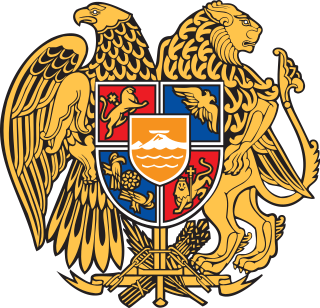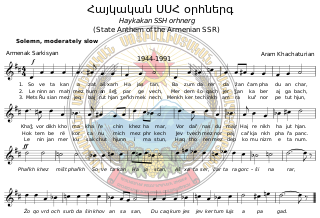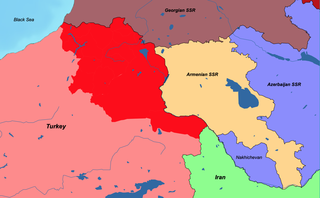| |||||
| Decades: | |||||
|---|---|---|---|---|---|
| See also: | Other events of 1984 List of years in Armenia | ||||
The following lists events that happened during 1984 in Armenia .
| |||||
| Decades: | |||||
|---|---|---|---|---|---|
| See also: | Other events of 1984 List of years in Armenia | ||||
The following lists events that happened during 1984 in Armenia .
| | This section is empty. You can help by adding to it. (May 2024) |

The politics of Armenia take place in the framework of the parliamentary representative democratic republic of Armenia, whereby the president of Armenia is the head of state and the prime minister of Armenia the head of government, and of a multi-party system. Executive power is exercised by the president and the Government. Legislative power is vested in both the Government and Parliament.

"Mer Hayreniḱ" is the national anthem of Armenia. It was arranged by Barsegh Kanachyan; the lyrics were written by Mikayel Nalbandian. First adopted in 1918 as the anthem of the short-lived First Republic of Armenia, it was subsequently banned after the country was invaded by then incorporated into the Soviet Union. Following the dissolution of the Soviet Union and the restoration of sovereignty in 1991, the song was re-adopted as the national anthem, albeit with slightly modified lyrics.

The State Anthem of the Armenian SSR was the national anthem of Armenia when it was a republic of the Soviet Union and known as the Armenian Soviet Socialist Republic. It was used between 1944 and 1991. Its music was composed by Armenian composer Aram Khachaturian, and the lyrics were written by Sarmen. Along with the Anthem of the Estonian SSR, it is one of the only two SSR anthems without an intro.

The "State Anthem of the Byelorussian SSR" was the regional anthem of the Byelorussian SSR, a republic of the Soviet Union. It was used from 1955 to 1991.

The Armenia national football team represents Armenia in men's international football, and is controlled by the Football Federation of Armenia, the governing body for football in Armenia.

Artsakh, officially the Republic of Artsakh or the Republic of Nagorno-Karabakh, was a breakaway state in the South Caucasus whose territory was internationally recognised as part of Azerbaijan. Between 1991 and 2023, Artsakh controlled parts of the former Nagorno-Karabakh Autonomous Oblast of the Azerbaijani Soviet Socialist Republic, including its capital Stepanakert. It had been an enclave within Azerbaijan from the 2020 Nagorno-Karabakh war until the 2023 Azerbaijani offensive, when the Azerbaijani military took control over the remaining territory controlled by Artsakh. Its only overland access route to Armenia after the 2020 war was via the five kilometres (3.1 mi)–wide Lachin corridor, which was placed under the supervision of Russian peacekeeping forces.

The Treaty of Kars was a treaty that established the borders between Turkey and the three Transcaucasian Soviet republics, which are now the independent republics of Armenia, Georgia and Azerbaijan. The treaty was signed in the city of Kars on 13 October 1921.

The First Nagorno-Karabakh War was an ethnic and territorial conflict that took place from February 1988 to May 1994, in the enclave of Nagorno-Karabakh in southwestern Azerbaijan, between the majority ethnic Armenians of Nagorno-Karabakh backed by Armenia, and the Republic of Azerbaijan with support from Turkey. As the war progressed, Armenia and Azerbaijan, both former Soviet republics, entangled themselves in protracted, undeclared mountain warfare in the mountainous heights of Karabakh as Azerbaijan attempted to curb the secessionist movement in Nagorno-Karabakh.

The Nagorno-Karabakh conflict is an ethnic and territorial conflict between Armenia and Azerbaijan over the region of Nagorno-Karabakh, inhabited mostly by ethnic Armenians until 2023, and seven surrounding districts, inhabited mostly by Azerbaijanis until their expulsion during the 1990s. The Nagorno-Karabakh region was entirely claimed by and partially controlled by the breakaway Republic of Artsakh, but was recognized internationally as part of Azerbaijan. Azerbaijan gradually re-established control over Nagorno-Karabakh region and the seven surrounding districts.

Serzh Azati Sargsyan is an Armenian politician who served as the third President of Armenia from 2008 to 2018, and twice as the Prime Minister of Armenia from 2007 to 2008 and again from 17 to 23 April 2018, when he was forced to resign in the 2018 Armenian revolution.

The Armenian Air Force is the air arm of the Armed Forces of Armenia formed by independent Armenia in 1992 in the wake of the dissolution of the Soviet Union. Outside its conventional name, it has also been referred to as the Aviation Department of the Armenian Armed Forces. It is organized and equipped principally to provide Armenian ground forces with tactical air support in the form of ground attack and airlift in mountainous terrain. It provided effective support during the battles with Azerbaijan in the Nagorno-Karabakh region from 1992 to 1994.

Armenia, officially the Republic of Armenia, is a landlocked country in the Armenian Highlands of West Asia. It is a part of the Caucasus region and is bordered by Turkey to the west, Georgia to the north and Azerbaijan to the east, and Iran and the Azerbaijani exclave of Nakhchivan to the south. Yerevan is the capital, largest city and financial center.

Republic Square is the central town square in Yerevan, the capital of Armenia. It consists of two sections: an oval roundabout and a trapezoid-shaped section which contains a pool with musical fountains. The square is surrounded by five major buildings built in pink and yellow tuff in the neoclassical style with extensive use of Armenian motifs. This architectural ensemble includes the Government House, the History Museum and the National Gallery, Armenia Marriott Hotel and two buildings that formerly housed the ministries of Foreign Affairs and Transport and Communications. The square was originally designed by Alexander Tamanian in 1924. The construction of most of the buildings was completed by the 1950s; the last building—the National Gallery—was completed in 1977.

There are no diplomatic relations between Armenia and Azerbaijan. The two neighboring states had formal governmental relations between 1918 and 1921, during their brief independence from the collapsed Russian Empire, as the First Republic of Armenia and the Democratic Republic of Azerbaijan; these relations existed from the period after the Russian Revolution until they were occupied and annexed by the Soviet Union, becoming the constituent republics of Soviet Armenia and Soviet Azerbaijan. Due to the five wars waged by the countries in the past century—one from 1918 to 1921, another from 1988 to 1994, and the most recent in 2016, 2020 and 2023—the two have had strained relations. In the wake of hostilities, social memory of Soviet-era cohabitation is widely repressed through censorship and stigmatization.

Bilateral relations between modern-day Armenia and the Russian Federation were established on 3 April 1992, though Russia has been an important actor in Armenia since the early 19th century. The two countries' historic relationship has its roots in the Russo-Persian War of 1826 to 1828 between the Russian Empire and Qajar Persia after which Eastern Armenia was ceded to Russia. Moreover, Russia was viewed as a protector of the Christian subjects in the Ottoman Empire, including the Armenians.

Iveta Roberti Mukuchyan is an Armenian-German singer. Born in Yerevan, Armenian Soviet Socialist Republic, she moved to Hamburg, Germany, in 1992. Mukuchyan returned to Armenia in 2009 and placed fifth in the fourth season of the talent competition Hay Superstar. During this time, she received vocal training at the Yerevan Komitas State Conservatory. Mukuchyan also participated for season two of The Voice of Germany in 2012.

The Union of Soviet Socialist Republics (USSR) was formally dissolved as a sovereign state and subject of international law on 26 December 1991 by Declaration № 142-Н of the Soviet of the Republics of the Supreme Soviet of the Soviet Union. It also brought an end to the Soviet Union's federal government and General Secretary Mikhail Gorbachev's effort to reform the Soviet political and economic system in an attempt to stop a period of political stalemate and economic backslide. The Soviet Union had experienced internal stagnation and ethnic separatism. Although highly centralized until its final years, the country was made up of 15 top-level republics that served as the homelands for different ethnicities. By late 1991, amid a catastrophic political crisis, with several republics already departing the Union and Gorbachev continuing the waning of centralized power, the leaders of three of its founding members, the Russian, Belorussian, and Ukrainian SSRs, declared that the Soviet Union no longer existed. Eight more republics joined their declaration shortly thereafter. Gorbachev resigned on 25 December 1991 and what was left of the Soviet parliament voted to dissolve the union.
Armenia participated in the Eurovision Song Contest 2014 with the song "Not Alone" written by Aram Mp3 and Garik Papoyan. The song was performed by Aram Mp3, who was selected internally by the Armenian broadcaster Public Television of Armenia (AMPTV) to represent Armenia in the 2014 contest in Copenhagen, Denmark. Aram Mp3's selection as the Armenian artist was announced on 31 December 2013, while the song "Not Alone" was later presented to the public on 14 March 2014 during a special presentation programme.

Aram Avetiki Sargsyan, better known by his stage name Aram Mp3, is an Armenian singer and comedian. He represented Armenia in the Eurovision Song Contest 2014 in Copenhagen with the song "Not Alone" and took the 4th place.

"Not Alone" is a song by Armenian singer Aram Mp3. It represented Armenia at the Eurovision Song Contest 2014 in Denmark. The song was revealed on 14 March 2014.